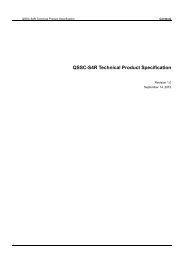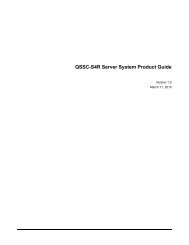Intel® Server System Server System "Emerald Ridge ... - CTL
Intel® Server System Server System "Emerald Ridge ... - CTL
Intel® Server System Server System "Emerald Ridge ... - CTL
Create successful ePaper yourself
Turn your PDF publications into a flip-book with our unique Google optimized e-Paper software.
錯 誤 ! 尚 未 定 義 樣 式 。 EPSFunctional SpecificationThe BMC implements this as a threshold sensor (IPMI sensor type = processor, sensor name =Therm Margin) on a per-processor basis. This sensor supports one threshold, the upper-critical,and it is set for 50% by default in the SDRs.3.15 Voltage MonitoringThe BMC provides voltage monitoring capability for voltage sources on the main board andprocessors such that all major areas of the system are covered. This monitoring capability isinstantiated in the form of IPMI analog/threshold sensors.The BMC provides 10-bit A/Ds for voltage monitoring. The BMC FW reads this 10-bit value andscales it to fit into the 1-byte data field supported by IPMI. The BMC knows what scale factor touse by retrieving it from an OEM SDR which provides a scale factor for each voltage sensor inthe system.The BMC firmware computes the sensor value as follows:SensorValue = (A/D10-Bit reading * Scale Factor) / 10000BMC also uses external SMBUS devices to monitor CPU voltages sensors.3.16 Standard Fan ManagementThe BMC controls and monitors the system fans. Each fan is associated with a fan speedsensor that detects fan failure and may also be associated with a fan presence sensor for hotswapsupport. For redundant fan configurations, the fan failure and presence status determinesthe fan redundancy sensor state.The system fans are divided into fan domains, each of which has a separate fan speed controlsignal and a separate configurable fan control policy. A fan domain can have a set oftemperature and fan sensors associated with it. These are used to determine the current fandomain state.A fan domain has four states: sleep, nominal, and lower boost and boost. The sleep lower boostand boost states have fixed (but configurable via OEM SDRs) fan speeds associated with them.The nominal state has a variable speed determined by the fan domain policy. See Section3.16.4. An OEM SDR record is used to configure the fan domain policy. See the descriptions ofthe TControl Fan Speed Control Record formats in Appendix A. The Set SM Signal commandcan be used to manually force the fan domain speed to a selected value, overriding any othercontrol or policy.The fan domain state is controlled by several factors. In order of precedence, high to low:Boost- Associated fan in a critical state or missing. The SDR describes which fan domainsare boosted in response to a fan failure or removal in each domain.Revision 1.1Intel ® Confidential 27









